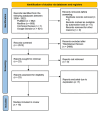The Rate of Postoperative Bile Leak in Minimally Invasive Liver Resection in Comparison With Open Surgery: A Systematic Review
- PMID: 39717317
- PMCID: PMC11665947
- DOI: 10.7759/cureus.74313
The Rate of Postoperative Bile Leak in Minimally Invasive Liver Resection in Comparison With Open Surgery: A Systematic Review
Abstract
The rapid advances in laparoscopic surgery have meant that formerly complex techniques are now commonly performed via this method. These practices are now becoming increasingly popular in the discipline of hepatopancreaticobiliary (HPB) surgery. One such example is liver resection, which is the focus of our review. We aimed to assess the rate of bile leak complications in minimally invasive liver resection compared to an open liver approach in malignant and benign conditions. A systematic review spanning the period from 2000 to 2022 was conducted, examining the postoperative complications in laparoscopic versus open liver resections. We searched the databases Medline, Cochrane, PubMed, and Google Scholar for relevant studies; 16 studies were included in the final analysis. Ten out of 16 studies that were included indicated that there was no significant difference in the rate of bile leaks. Five studies showed that bile leaks were found to occur more frequently in open surgery, and one study suggested that the rates were more common with the laparoscopic approach. The overall comparison of bile leak rates following open and minimally invasive liver resection suggests that there is no reduction in this complication in both types of surgery. As such, a laparoscopic or open method can both be adopted without any concerns for this particular complication.
Keywords: hepatectomy; hepatobiliary surgery; laparoscopic liver resection; open liver resection; post-operative complications.
Copyright © 2024, Elmahi et al.
Conflict of interest statement
Conflicts of interest: In compliance with the ICMJE uniform disclosure form, all authors declare the following: Payment/services info: All authors have declared that no financial support was received from any organization for the submitted work. Financial relationships: All authors have declared that they have no financial relationships at present or within the previous three years with any organizations that might have an interest in the submitted work. Other relationships: All authors have declared that there are no other relationships or activities that could appear to have influenced the submitted work.
Figures
Similar articles
-
A Literature Review to Assess Blood Loss in Minimally Invasive Liver Surgery Versus in Open Liver Resection.Cureus. 2021 Jun 28;13(6):e16008. doi: 10.7759/cureus.16008. eCollection 2021 Jun. Cureus. 2021. PMID: 34336498 Free PMC article.
-
Bile Leak Reduction with Laparoscopic Versus Open Liver Resection: A Multi-institutional Propensity Score-Adjusted Multivariable Regression Analysis.World J Surg. 2020 May;44(5):1578-1585. doi: 10.1007/s00268-019-05343-x. World J Surg. 2020. PMID: 31897695
-
World review of laparoscopic liver resection-2,804 patients.Ann Surg. 2009 Nov;250(5):831-41. doi: 10.1097/SLA.0b013e3181b0c4df. Ann Surg. 2009. PMID: 19801936 Review.
-
Minimally invasive versus open hepatectomy for the resection of colorectal liver metastases: a systematic review and meta-analysis.Surg Endosc. 2022 Nov;36(11):7915-7937. doi: 10.1007/s00464-022-09612-0. Epub 2022 Sep 22. Surg Endosc. 2022. PMID: 36138246
-
Laparoscopic versus open hepatectomy for malignant liver tumours in the elderly: systematic review and meta-analysis.Updates Surg. 2021 Oct;73(5):1623-1641. doi: 10.1007/s13304-021-01091-7. Epub 2021 Jul 6. Updates Surg. 2021. PMID: 34228272
Cited by
-
Endoscopic Bridging Stent Placement Improves Bile Leaks After Hepatic Surgery.J Clin Med. 2025 May 13;14(10):3381. doi: 10.3390/jcm14103381. J Clin Med. 2025. PMID: 40429376 Free PMC article.
References
-
- Comparison of laparoscopic versus open left lateral segmentectomy. Zhang Y, Chen XM, Sun DL. https://pubmed.ncbi.nlm.nih.gov/25785073/ Int J Clin Exp Med. 2015;8:904–909. - PMC - PubMed
-
- Global trends and predictions in hepatocellular carcinoma mortality. Bertuccio P, Turati F, Carioli G, Rodriguez T, La Vecchia C, Malvezzi M, Negri E. J Hepatol. 2017;67:302–309. - PubMed
-
- Location affects the management of liver haemangioma: a retrospective cohort study. Liu X, Yang Z, Tan H, et al. Int J Surg. 2017;48:110–115. - PubMed
Publication types
LinkOut - more resources
Full Text Sources
Research Materials

